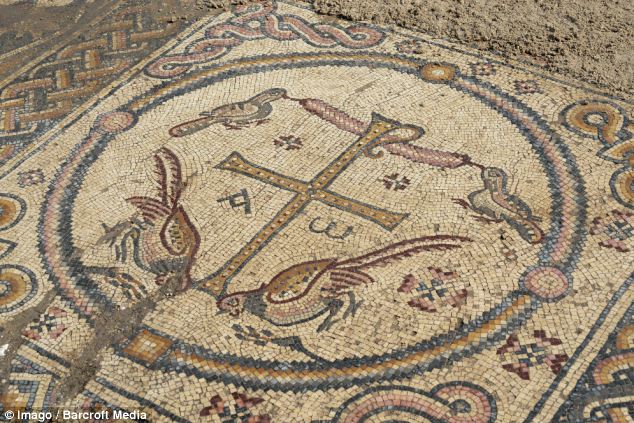A reader sent me a link to an article at The Mail about a newly discovered mosaic floor of a 1500 year-old Byzantine church some 30 miles south of Tel Aviv, Israel.
There are lots of photos available, but here is one to whet the old appetite.
There are all sorts of critters in these mosaics. The floor must have been spectacular.
And to think that some people have to endure carpet in their churches. O the black grief of the world.



































Carpet indeed, and much worse than that I’m afraid. My closest Latin Catholic parish is built like a gymnasium with a vaulted ceiling of wooden beams and wooden everything else, including a wooden dinner table for an Altar and a wooden tabernacle. Funny how Catholics fifteen hundred and more years ago had such a profound sense of the Beauty that is God that they adorned the Temples of God to reflect that glory. I wonder if perhaps we’ve drifted (sarcasm).
Thank you for the news of this splendid mosaic work! I’ll have to brush up what I once sort-of knew about textiles in antiquity, but more recently (a mere half-millennium ago, I think) weren’t carpets usually consider too fine to put on the floor? (Memories of Holbein portraits arise…)
These are gorgeous!
I’m not sure why I hate carpets in church more: because they look tacky, or because of how they eat up sound waves. The Basilica of the Sacred Heart, the beautiful church on the campus of the University of Notre Dame, just installed a new slate floor to replace its old 1970’s carpet, and apparently it’s a night-and-day difference in sound quality for the organ and choirs.
Not long ago, my parish completed a renovation of the interior of the church. We took out a bunch of old carpet, put tiles on the floors, removed lots of sound absorbing material from the ceiling, and brightened the place up in some ways, while making the ceiling darker.
WOW, what a difference!
We had the pleasure of holding Mass for the very first time for Midnight Mass for Christmas. I kept waiting for someone to shake me awake and show me the old interior.
..and then we sang…
hoooooo-eeeeeee!! I’d forgot how acoustics and make a difference!
I do pity folks who attend Mass in a dreary church with carpet and an electronic organ with speakers.
Now, if we could find the money to refurbish the pipe organ..or buy a new one.
Well, we have a good start!
Hmm. (clears throat)
..just read over our parish bulletin again, apparently our floors aren’t tile. ..They’re marble!
Ah what sight and sound……
(I’d dance a jig if I knew how)
I first saw the photos of this floor on the website of a local Protestant newspaper. I immediately wondered what they would think of the lavish decorations that these early Christians enjoyed as compared to their own bare whitewalled meeting halls.
I am curious as to the symbolism on the mosaic – for example by are the 2 birds at the top pulling on what looks like a foot long hot dog? (Didn’t know Nathan’s was in operation in 500 AD!).
Vosizneias says that the archaeologists say that the birds are lifting the Cross to heaven, and that the strips in their beaks are basically ropes or ribbons to do that with. Other articles say it’s really a Chi Ro or Christogram, and not the Cross per se.
Also, Haaretz says:
“Among the animals depicted in the mosaic are a wild boar, a pair of mice, a giraffe, zebra, flamingo, partridge, leopard, bear, rabbit, a cage containing what appear to be birds, a pair of peacocks and a chameleon. One of the medallions, which is believed to have contained the image of a human being, was carefully destroyed. Varga believes this was the work of devout Christians who opposed the presence of human images in the church during the Byzantine period.
“The fact that some of the animals appear to be stepping out of their medallions allowed the church to be dated to the second half of the sixth century — roughly 1,500 years ago — when such depictions were in fashion among mosaic artists.”
JonPatrick,
If you’re near a good library you might see if they have Frederik van der Meer’s Early Christian Art (1967, and reprints) or – if you read German – his Die Ursprünge christlicher Kunst (1982), which oddly seems never to have been translated into English (I don’t have time to go searching myself just now…)
It looks (after the initial shock!) like a garland or ribbon to me. In an article by Dr. van der Meer which I do just have to hand, he discusses the development of the ‘Cross Trophy’ on Roman sarcophagi from c. 335: a laurel Victory Wreath around a Chi-Rho suspended from the beak of an eagle with ribbon-ends fluttering down from the wreath and doves just below it on the cross-beam of the Roman-style trophy which doves he interprets as alluding to the souls delivered from death by the Heavenly Triumphator, Christ (at least in the example from the Vatican Museum which he discusses). For all its differences, I can imagine this encircled Chi-Rho mosaic with birds might have something in common with that iconographic tradition.
Stunning!
I saw this yesterday. Truly splendid!
What, no carpet? That means when the “Eucharistic Ministers” drop the stemmed wineglasses used for “serving the wine” on the floor, they’ll break…. Oh, wait….. Hmm.
. . . and the liturgical dancers will get cold feet and stub their toes . . . oh, wait . . . .
Beautiful mosaics. They must date to before Justinian II in the 690’s as the Trullo Council forbade decorations with the Cross on the floor of churches. Good idea!